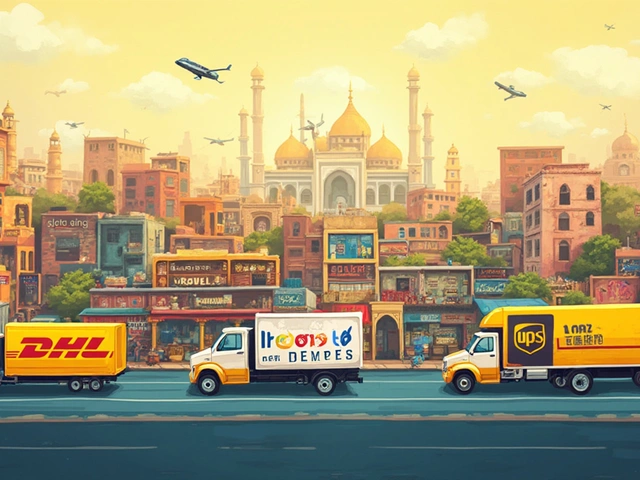Shoppers don’t remember your warehouse workflow-they remember how their parcel arrives, when it lands, and how you handle problems. That’s the promise and the pressure of modern delivery. If you’ve ever watched a carefully nurtured cart evaporate at checkout, you know why this matters: delivery cost, speed, and clarity are deal-breakers. This piece explains what e‑commerce delivery actually is, how it works from click to door, the options you can offer, and the nitty‑gritty that keeps costs sane and customers happy. Expect straight talk, UK‑friendly examples (I’m writing this from Bristol), and practical checklists you can use today.
TL;DR: What is e‑commerce delivery?
- Definition: e-commerce delivery is everything that happens after a customer places an online order to get the product into their hands-picking, packing, carrier handoff, transport, last‑mile, delivery confirmation, and returns.
- Why it matters: Delivery is the biggest friction at checkout. Baymard Institute (2024) found 47% of US shoppers abandon carts due to extra costs (shipping/taxes/fees), and 22% due to slow delivery. The pattern tracks closely in the UK and EU.
- Common options: Standard (2-5 days), Next‑day, Same‑day (in select postcodes), Click & Collect/PUDO (pickup points), Scheduled delivery for bulky items, and cross‑border services (DDP/IOSS for EU under €150).
- Who’s involved: Your store/OMS/WMS, your warehouse or 3PL, carriers (e.g., Royal Mail, DPD, Evri, UPS, DHL), and your customer via tracking and delivery preferences.
- Key KPIs: On‑Time Delivery (OTD), First‑Attempt Delivery Rate (FADR), Delivery Promise Accuracy (DPA), Cost per Order (CPO), WISMO (“Where is my order?”) contact rate, and return rate.
Jobs you likely want to get done after clicking this:
- Understand how the delivery flow really works, step by step.
- Pick the right delivery options (and set clear delivery promises that you can keep).
- Control shipping costs without tanking speed.
- Choose carriers and tech that fit your order profile.
- Design tracking, comms, and returns that reduce support tickets.
- Handle special cases: international, bulky, fragile, and perishable goods.
How e‑commerce delivery works, end to end
At a glance, delivery looks simple: label on, carrier out, parcel delivered. In reality, small frictions add up. Here’s the flow that works whether you ship 5 or 5,000 orders a day.
- Order confirmed: Your store captures the order and pushes it to your order management system (OMS) or WMS. The clock starts here. Pro tip: show an order cutoff time for next‑day (e.g., “Order by 5pm for next‑day”).
- Inventory allocated: The system reserves stock from the right location. If you have multiple sites, choose the closest in‑stock location to cut transit time and cost.
- Pick: Use digital picklists, batch picking for similar SKUs, and clear bin locations. Scanning reduces mis‑picks and returns. Target pick accuracy above 99.5%.
- Pack: Choose packaging that protects without triggering dimensional weight (volumetric) surcharges. Heuristic: Use the smallest safe box, fill voids wisely, and keep letterbox‑friendly formats when possible (Royal Mail Large Letter vs Small Parcel has a big price step).
- Label: Your shipping system rates and prints labels based on rules (e.g., cheapest next‑day under 2kg, signature for orders over £150). Automate HS codes for international orders.
- Carrier handoff (first mile): Either you drop at a depot/shop or the carrier collects. Hitting your dispatch deadline is as important as your customer’s order cutoff.
- Sortation and linehaul: The parcel goes through the carrier’s network hub(s) and travels toward the destination area. This is where most delays happen-peak season, weather, or strikes can bite. Buffer for that in your promise.
- Last‑mile: The local depot loads the van, bike, or EV for delivery. Success here depends on address quality, delivery preferences, and the driver’s route density.
- Delivery attempt(s): Depending on service, the driver may leave safe, with a neighbour, in a locker, or require a signature/ID. First‑Attempt Delivery Rate above 95% keeps costs and complaints down.
- Confirmation and comms: Scan events update tracking. Send SMS or email proactively when status changes (“Out for delivery”, “Delivered”). Keep WISMO contacts under 5% of orders if your tracking and messaging are clear.
- Exceptions: Lost, damaged, or delayed? Have a playbook: re‑ship, refund, or both depending on value and customer lifetime value (CLV). File claims within carrier time limits.
- Returns: Provide pre‑printed or portal‑generated labels, drop‑off points, and clear timelines. UK online purchases sit under the Consumer Contracts Regulations: most goods allow 14 days to cancel after delivery and a further 14 to return after notifying.
Delivery promise math you can actually use:
- Promise date = Order cutoff logic + Handling time + Carrier transit time (at P90) + Buffer (typically 0.5-1 day in peak).
- Example (UK next‑day): Order by 5pm, handling 0.5 day, transit 1 day (P90), buffer 0.5 in peak = “2 days” promise that usually arrives next day. Under‑promise beats apology emails.
Keeping costs in check without slow delivery:
- Use a free‑shipping threshold roughly 10-20% above your current AOV. This nudges baskets up while protecting margin. Shopify Plus analyses (2023) show thresholds lift AOV when messaged well.
- Split options: Offer free standard, paid express. Let customers self‑segment by urgency.
- Dimensional weight: Most couriers price by max(actual weight, volumetric weight). Volumetric formula is often (L × W × H in cm) / 5000. Check your carrier’s divisor.
- Zone logic: Remote area surcharges apply. Be transparent in checkout; hiding exclusions (“UK mainland only”) attracts complaints and ASA/CMA headaches.
What “good” looks like by KPI:
- OTD (on‑time delivery): 95%+ in non‑peak, 90%+ in peak is solid for standard services in the UK.
- FADR: 95%+ (drops with signature‑required services; consider safe‑place options where appropriate).
- DPA (delivery promise accuracy): 97%+ (keep your promise tight but realistic).
- CPO (shipping cost per order): Varies by size/weight; aim for 8-12% of order value for typical D2C parcels, lower with volume and good packaging.
- WISMO rate: Under 5% of orders contacting support about delivery. Great programs hit 2-3%.
Credible context: Ofcom’s monitoring of the UK parcels market has shown billions of parcels moving annually and strong competition among national and private carriers; competition helps pricing, but service levels swing during peak. Baymard’s research consistently puts delivery cost and speed at the top of checkout friction. The pattern holds across markets, so the fundamentals here age well.

Options, examples, and the practical playbook
Here are the delivery options most stores offer, plus when to use them. I’ve included UK carriers you’ll actually see in the wild.
| Option | Typical speed (UK) | When to offer | Pros | Watch‑outs | Common carriers |
|---|---|---|---|---|---|
| Standard | 2-5 working days | Default for most baskets; free above threshold | Cheapest; broad coverage | Expectation management; peak delays | Royal Mail 48, Evri 2-3, Yodel |
| Next‑day | 1 working day | Upsell at checkout; time‑sensitive items | Conversion lift; predictable | Cutoff discipline; cost spikes for heavy items | DPD Next Day, Royal Mail Tracked 24, UPS |
| Same‑day | Hours (limited postcodes) | High‑urgency, local radius | Premium CSAT; differentiation | Small coverage; expensive | Stuart, Gophr, CitySprint |
| Pickup & Locker (PUDO) | 1-3 days to point | Urban, privacy‑minded shoppers | High first‑time success; fewer thefts | Extra step for customer | InPost, CollectPlus, DPD Pickup |
| Scheduled/2‑man | 2-7 days | Bulky/furniture/appliances | Room of choice, installation | Complex scheduling; returns cost | Panthers/2‑man specialists, ArrowXL |
| International (EU under €150) | 3-8 days EU; 5-12 ROW | Cross‑border growth | IOSS simplifies VAT for EU | DDP vs DAP clarity; customs delays | DHL, UPS, Royal Mail Intl Tracked |
Three realistic setups
- Side‑hustle or micro‑brand (0-20 orders/day): Use Royal Mail Tracked 24/48 from the Post Office or business account. Offer free standard (48) over £30, charge £4-£6 for 24. Pack to Large Letter when you can (max thickness 2.5cm) to save pounds per order. Print labels with a lightweight app and a simple scale.
- Growing D2C brand (50-500 orders/day): Add a second carrier (e.g., DPD) for next‑day reliability. Use a rules‑based shipping platform to auto‑select services. Introduce PUDO at checkout-it can lift first‑attempt success and reduce porch theft. Consider a 3PL if your order volume spikes seasonally and you want later cutoffs.
- Marketplace + international (100+ orders/day mix): Use IOSS for EU orders under €150 so buyers see tax‑inclusive pricing and avoid doorstep fees. Offer DDP for high‑value baskets to kill friction. Harmonise HS codes in your catalog; one bad code can stall an entire sack at customs.
Heuristics that save headaches
- Promise less, delight more: Quote 2-3 days for services that usually land next day, especially in peak.
- 90/10 rule for options: Cover 90% of orders with two options (free standard, paid express). Add niche services only if they move the needle.
- Free‑shipping threshold: Start at AOV + 15%. If free‑ship share >70% and margins hurt, raise threshold by £5-£10 and watch conversion for two weeks.
- Dimensional traps: Redesign a box that pushes you over a volumetric step-small packaging tweaks often cut 10-20% off shipping costs.
- Cutoff discipline: Publish cutoff times and stick to them. Late pickups silently destroy OTD.
Returns policy that doesn’t backfire
- Be plain: “30‑day returns. Use the portal. Free over £X, £Y otherwise.” Ambiguity drives tickets.
- Instant credit for exchanges: Offer store credit the moment the carrier scans the return. This turns refunds into repurchases.
- Photographic proof: Ask for a quick photo for damaged/DOA claims. It speeds replacements and supports carrier claims.
Packaging basics
- Right‑size boxes. Use mailer boxes or padded envelopes for small, durable items.
- Protect fragile items with internal suspension or molded inserts; peanuts migrate and aren’t customer‑friendly.
- Sustainability that’s visible: Recyclable materials and right‑sized boxes cut costs and please customers. Shoppers notice when a tiny item comes in a shoe‑box.
Compliance and claims (UK‑centric notes)
- Consumer Contracts Regulations: Most goods bought online can be cancelled within 14 days of delivery; customers then have another 14 days to return after telling you. Some goods are exempt (e.g., perishables, bespoke).
- ASA/CMA advertising: Be clear about delivery limitations. If you exclude certain postcodes or offshore, say so before checkout.
- Age‑restricted items: Use adult‑signature services and appropriate ID checks at delivery.
Checklists, tools, and worked examples
Delivery promise checklist (copy/paste this into your SOP)
- Publish order cutoff times by service.
- Quote delivery windows with a buffer (use P90 transit times).
- Show options early (product page/cart), not just at payment.
- Offer PUDO where address issues are common.
- Display clear returns terms before checkout.
Carrier selection checklist
- Coverage: Do they hit your key postcodes consistently?
- Service mix: Standard, next‑day, PUDO, international-what gaps remain?
- Performance: Ask for depot‑level OTD, FADR, peak plans.
- Pricing: Base rates, fuel surcharges, remote area fees, volumetric divisor.
- Tech: Live tracking webhooks, delivery options (safe place, neighbour), branded tracking page support.
- Claims: Process clarity and average resolution times.
Operations checklist
- Scan at pick and pack to cut mis‑ships.
- Weigh and dimension at pack for accurate labels.
- Daily pickup performance reviews-missed scans and late pickups escalate fast.
- Exception playbook: Lost, damaged, delayed-who does what by when.
- Peak plan: Extra hands, earlier cutoffs, safety stock for mailers and labels.
Simple cost model (worked example)
You sell skincare, AOV £38, average parcel 0.6kg actual, 30×20×6 cm (volumetric 0.72kg). Standard service costs £2.70-£3.30, next‑day £5.00-£6.50. You set free standard at £45 and charge £4.99 for next‑day. If 40% of orders hit the threshold and 20% choose next‑day, your blended shipping CPO might be ~£3.90. On a £38 AOV, that’s ~10.2%. Not bad. Nudge the threshold to £47 in peak if costs creep.
Volumetric weight formula refresher
- Volumetric (kg) = (L × W × H in cm) / 5000 for many courier services.
- Billable weight = max(actual kg, volumetric kg).
- Try trimming one dimension by 1-2 cm to cross a pricing step.
International quick wins
- EU orders under €150: Use IOSS to collect VAT at checkout and speed clearance.
- DDP vs DAP: DDP (duties paid) removes doorstep fees and surprises; conversion tends to improve for higher‑value baskets.
- Classify properly: Use correct HS codes and product descriptions (no marketing fluff in customs data).
- Localisation: Show duties/taxes estimator in checkout for non‑EU destinations.
Communication blueprint
- Order confirmation: Plain language, order summary, cutoff reiterated.
- Dispatch notice: Tracking link + delivery window + how to set preferences (safe place, neighbour, locker).
- Out‑for‑delivery: Short SMS/email; encourage safe‑place selection if the customer won’t be in.
- Delivered: Photo or GPS proof where supported. Tell customers how to flag an issue (1‑click form).
- Exception: Apology + action (“We’ve re‑shipped,” “Here’s your refund”). No waffle.
Data points worth knowing
- Baymard (2024): 47% abandon due to extra costs; 22% due to delivery too slow. Cleaning up delivery clarity hits both.
- UK parcels are measured in billions annually (Ofcom monitoring). Peak volatility is normal-plan buffers and honest messaging.
- Shopper behaviour: Pickup/locker options reduce missed deliveries and theft, especially in dense areas.

FAQ, next steps, and troubleshooting
FAQ
- What’s the difference between fulfillment and delivery? Fulfillment is everything up to handoff to the carrier (pick, pack, label). Delivery is the carrier’s job from pickup to doorstep, including tracking and proof of delivery. Your customer sees it as one promise, so treat it that way.
- Is free shipping worth it? Often yes, if tied to a threshold. It increases AOV and conversion but must be modelled. Start with AOV + 15% and watch margin. Offer paid express for urgency.
- Which carrier is “best”? None universally. For small parcels, Royal Mail is hard to beat on reach/cost; for predictable next‑day with good comms, DPD is a favourite; for international speed, DHL/UPS shine. Mix and match by parcel type and destination.
- What KPIs should I review weekly? OTD, FADR, WISMO rate, CPO, and top exception reasons. If WISMO spikes, your tracking and comms need work.
- Do I need shipping insurance? For high‑value or fragile items, yes-if the cost is <1-2% of item value and claims are honoured. Otherwise, invest in better packaging and tracking.
- How do I quote delivery dates accurately? Use percentile transit times (P90) from your carrier data + handling + buffer. Show a range, not a single day, unless you truly control the variables.
- What about sustainability? Right‑size packaging, avoid excess void fill, and offer PUDO. Many UK carriers are adding EV routes; note it, but don’t over‑promise on carbon claims.
Troubleshooting by scenario
- Small brand, no 3PL, inconsistent OTD: Tighten your cutoff, simplify options (free standard, paid next‑day), batch pick twice daily, and commit to pickup times. One reliable carrier beats three inconsistent ones.
- High damage rates on fragile goods: Move from loose fill to engineered protection (inserts, double‑wall boxes), add “This side up” where it matters, and test a service with gentler handling even if it costs more. Track SKUs with repeated damage and redesign packaging.
- WISMO tickets exploding: Brand your tracking page, add proactive status emails/SMS, and make delivery options editable after dispatch (safe place, neighbour) where the carrier allows.
- International returns pain: Use a returns portal that generates local labels and consolidates returns into bulk shipments back to the UK. Clarify DDP/DAP at checkout to avoid “pay on delivery” surprises.
- Peak season delays: Pull forward your cutoff by an hour, add a 0.5‑day buffer to promises, stock up on consumables (labels, tape), and pre‑pack top sellers. Keep a “Plan B” carrier account available.
- Bulky items, failed deliveries: Switch to scheduled or two‑man delivery with time windows and pre‑call. The extra cost beats the chaos of repeated failed attempts.
Next steps you can execute this week
- Audit your checkout: Are delivery options clear, shown early, and priced sensibly? Fix wording today.
- Set or update your free‑shipping threshold to AOV + 15% and test for two weeks.
- Add a PUDO option if your carrier supports it; highlight it for urban postcodes.
- Create a one‑page exception playbook (lost, damaged, delayed) with actions and SLAs.
- Pull last 90 days of carrier data to calculate P90 transit times and update your delivery promises.
Last thought: delivery isn’t about chasing the absolute fastest option. It’s about making a promise customers understand, then hitting it with boring consistency. Do that, and the five‑star reviews tend to take care of themselves.





